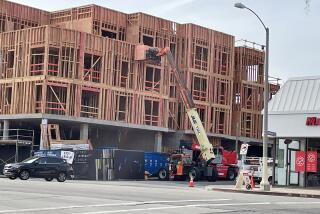Urban Boundary Line Proposed for Thousand Oaks
- Share via
THOUSAND OAKS — Hoping to prevent this city from blending into its neighbors like so many other Southern California communities, Councilwoman Linda Parks has proposed the creation of urban boundary limits on the outskirts of town.
Parks will ask the City Council on Tuesday to establish an urban boundary line around Thousand Oaks that would discourage development in greenbelt areas at the edges of the city, a slow-growth tactic already utilized in San Luis Obispo and other California municipalities.
She said she believes such a line would help Thousand Oaks retain its own urban identity while protecting the farmland and open space within the city’s sphere of influence.
Currently, open space helps separate Thousand Oaks from Simi Valley, Moorpark and Camarillo, but residential development has already blurred the boundaries with its Los Angeles County neighbors to the east.
Placing the urban boundary line in the city’s General Plan--its blueprint for growth--could prevent annexations of county farmland and open space into Thousand Oaks for development, which Parks strongly opposes.
“I see it as a planning tool,” Parks said Friday as she drove to San Luis Obispo to study its greenbelts. “Thousand Oaks talks about a ring of open space and greenbelts. This would help define it.”
A greenbelt is an area, usually between cities, that is set aside to be development free; an urban boundary line is a city’s pledge that its growth will not extend beyond a specified point.
The Woodridge development, a proposal to build 326 residences in the unincorporated county “buffer” area between Thousand Oaks and Simi Valley, was one of the issues that Parks said spurred her into action.
But because the plans for Woodridge are already making their way through the Thousand Oaks bureaucracy, Parks said it might not be legal or fair to keep the development out of an urban limit zone.
“That would be a council decision as to whether they would want it to apply to a project already in the hopper, so to speak,” Parks said. “This is looking to the future, but part of the reason for it was obviously the Woodridge development.”
Councilman Andy Fox said he is willing to consider Parks’ proposal, but believes it must be thought out in considerably more detail if it is to become reality. Parks’ proposal does not include a specific set of boundaries at this point, though Parks said she has some in mind, such as the Potrero Road area in Newbury Park.
“I think we ought to take a look at it,” Fox said. “I’m not exactly sure what this is about--her proposal is not too clear--but it’s certainly something for our staff to take a look at. We need to be very careful about this and not do anything willy-nilly.”
Steve Van Landingham of the Bay Area-based Greenbelt Alliance has helped numerous cities and growth-control groups create urban boundary limits, including San Jose, where the City Council recently approved a boundary plan with a unanimous 11-0 vote.
He said boundaries, which are usually set for 20 to 30 years, can be helpful tools because they give residents and farmers an assurance that urban sprawl will not overtake them. The boundaries have more often been set down by voters through the initiative process, but growth-wary cities are increasingly drawing them up on their own, he said.
“What an urban growth boundary does, in its simplest form, is designate what land should be built out and what land should be protected,” Van Landingham said. “What it does is take some of the rampant speculation about how communities develop out of the equation. A lot of time, land is developed because it is there, not taking into account its other merits.”
Arnold Jonas, community development director for San Luis Obispo, said the city set urban growth boundaries as part of its General Plan. The growth boundary is then surrounded by a separate greenbelt area, and the two zones work in concert, Jonas said.
“It shows what our city believes--at least at the time--to be the ultimate point we would grow to,” Jonas said.
Jonas said the boundary has largely been effective in San Luis Obispo. But he stressed that such boundaries are not a definitive way to control growth unless counties and other neighboring cities agree with the concept.
San Luis Obispo County, for example, decided to allow some industrial zoning within its jurisdiction just outside the city of San Luis Obispo’s growth boundary, a decision that undermined the city’s efforts, he said.
“Cities are best at urban development, and counties are best at rural development,” Jonas said. “Frankly, counties are often not equipped to deal with development as well. You really need to work with the county to make it work for you.”
Councilwoman Elois Zeanah, a strong Parks supporter, said a growth boundary could only help Thousand Oaks leaders achieve what they have already pledged to do: preserve open space and farmland and prevent the city from merging into Simi Valley and Moorpark.
“It seems like every month I’m reading something in the papers about the greenbelts being penetrated in this county,” Zeanah said. “Unless we put some teeth into our guidelines to back these promises we have made, there is no doubt in my mind that we will end up with cities touching each other, just a sea of concrete.”
More to Read
Sign up for Essential California
The most important California stories and recommendations in your inbox every morning.
You may occasionally receive promotional content from the Los Angeles Times.









